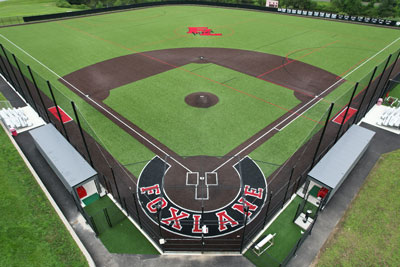A number of factors have contributed to the growth of athletic turf fields in recent years, with many high schools, colleges and universities, pro sports teams, and parks and community facilities opting for synthetic turf as a reliable and sustainable solution for their athletic field needs.
So, what are the top reasons for the growing popularity of synthetic turf fields over natural grass fields?
- All-Weather Playability: Synthetic turf fields withstand adverse weather conditions, unlike natural grass fields, which often become muddy and unplayable after heavy rain. Turf fields can drain quickly and provide consistent play even in the wettest conditions.
- Extended Play Times: Natural grass fields need rest and recovery, maintenance and rejuvenation to prevent damage from overuse. Turf fields hold up to extended playing hours and continuous use—allowing for more practices, games and other events all on the same surface.
- Cost and Maintenance: While turf fields require a larger initial investment, they provide far lower long-term maintenance costs—with no mowing, no water and no use of fertilizers or pesticides.
- New Turf Technologies: Advancements in turf technologies have led to the development of many new types of high-performance synthetic turf systems. Modern turf fields are designed to mimic the playing characteristics of natural grass in pristine condition while offering much better drainage, outstanding durability and ideal shock absorption.
Considerations When Deciding on a New Turf System
If you’re in the market for a new turf system, there are many important points to consider. Working with a reputable turf

field builder is critically important, as they’ll have the proven products and the necessary experience to help you make the most informed decision for your needs.
Here are six important considerations when deciding on the most suitable turf system for your next project:
- Performance Requirements: Choose a system that meets fundamental demands such as traction, ball rolls, shock absorption and player comfort. As a facility owner, talk with your coaches, athletes and sports associations to ensure characteristics of your new turf system meet these fundamentals.
- Durability: Athletic fields experience consistently heavy use, making durability a critical characteristic. Look for turf options that can stand up to heavy foot traffic, will resist wear and tear, and remain consistent 24/7 all year round. The specific composition of materials used in the turf will contribute to the longevity and resilience of your system.
- Player Safety: Player safety is a top priority for turf fields. Choose a system that offers ideal shock absorption to minimize the risk of player injuries, as well as a turf system with an excellent balance of traction and foot release.
- Maintenance: Be sure to know the maintenance guidelines. While they are minimal, they are important.
- Drainage: Excellent drainage capabilities to ensure
efficient water removal from the turf playing surface is a must. - Environmental Factors: Think about the environmental impact of the turf systems you’re considering. Work with a field builder with a recycling program.
Optimal Performance & Value
When searching for a synthetic turf company, choose a partner that has a reputation for delivering a superior experience at all levels—product, installation, customer service and warranty. Best value is key! RM
ABOUT THE AUTHOR
James Dobmeier, the founder of A-Turf and Surface America, is the president of Ecore International’s Construction Units, specializing in building the industry’s leading synthetic athletic fields and rubber playground surfaces. For more information, visit www.aturf.com.



